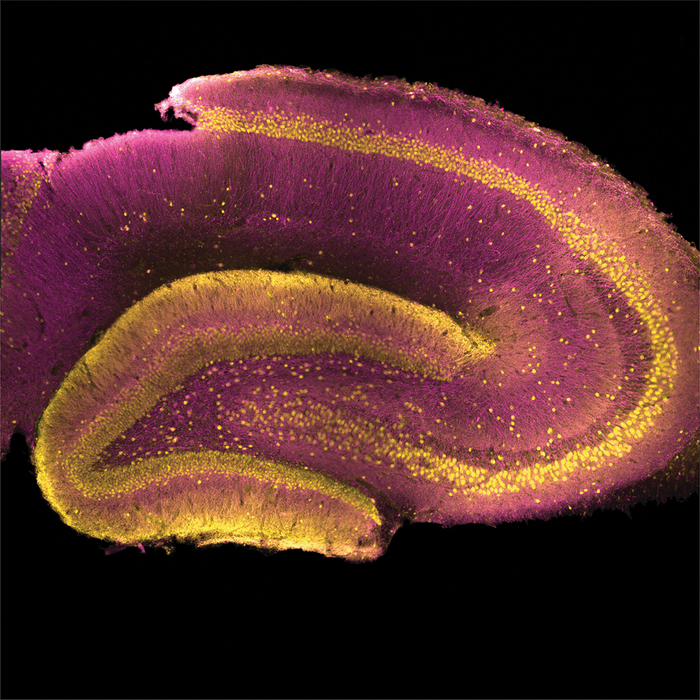In the process of solving a decades-long mystery about a particular protein, scientists have identified a specific location in the brain where schizophrenia may originate.

Credit: USC Dornsife/Yuni Kay
In the process of solving a decades-long mystery about a particular protein, scientists have identified a specific location in the brain where schizophrenia may originate.
The news: Despite the identification of many genes that show some link to schizophrenia, identifying a part of the brain that is likely responsible for the disorder with a high level of certainty has proven to be extremely difficult — until now.
Why it’s important: Knowing where to look and what to look for could help identify those at risk of schizophrenia before the disorder strikes and might lead to new diagnostic, preventive and treatment measures.
- Schizophrenia affects about 20 million people around the globe.
- Symptoms include hallucinations, delusions, flat affect (lack of emotional expression), loss of a sense of personal identity, and memory loss.
A protein without a role
The study, led by researchers at the USC Dornsife College of Letters, Arts and Sciences and published online Feb. 10 in Nature Communications, centers on a protein called synapse-associated protein 97, or SAP97, that is found in neurons in the brain.
- Scientists have recently discovered that mutations inhibiting SAP97 function can give rise to schizophrenia.
- These mutations are linked to a 40-fold increase in the risk of developing schizophrenia — the largest increase in risk documented for any mutation to date.
- The normal function of SAP97 — that is, what it normally does and where it does it in the brain — has remained elusive for many years.
- Not knowing how or where the protein works has also kept a veil over why mutations in SAP97 would lead to schizophrenia.
From the principal researcher: “Reduced SAP97 function may very well give rise to the largest increase in schizophrenia risk in humans that we know of, but the function of SAP97 has been a total mystery for decades. Our study reveals where SAP97 functions in the brain and shows exactly what schizophrenia-associated mutations in this protein do to neurons.”
— Bruce Herring, assistant professor of biological sciences at USC Dornsife
A deeper look
SAP97 belongs to a family of proteins that regulate glutamatergic signaling between neurons and influence how memories are created and stored.
- Glutamatergic signaling is an important way neurons communicate with each other that involves neurons releasing the neurotransmitter glutamate onto neighboring neurons.
- Experiments up to now have failed to show that SAP97 plays any significant part in regulating glutamatergic signaling in the brain.
- The lack of evidence for SAP97 function in regulating communication between neurons has frustrated scientists, given the growing evidence of the protein’s connection to schizophrenia.
What they did: With no SAP97 activity apparent in traditionally studied brain regions, Herring and his team chose to look at a different region of the brain that has been theoretically linked to schizophrenia, called the dentate gyrus.
- The dentate gyrus is located within the hippocampus.
- It controls contextual episodic memory — the conscious recollection of life experiences that includes what happened along with when and where it happened.
- Contextual episodic memory is often altered in those with schizophrenia, and such alterations may contribute to the development of other symptoms associated with the disorder.
Studying rats with damaged SAP97, the researchers looked for changes in activity in the dentate gyrus — and they found them.
- Neurons in the dentate gyrus with reduced SAP97 function showed extremely large increases in glutamatergic signaling.
- The increase in signaling with mutated SAP97 suggests the protein normally helps dampen glutamatergic signaling specifically within the dentate gyrus.
- The large increases in glutamatergic signaling in the dentate gyrus caused by reduced SAP97 function also produced significant deficits in contextual episodic memory in rodents — a hallmark of schizophrenia.
A scientific first: The results are the first to confirm where in the brain SAP97 is active and to directly link alterations in dentate gyrus function to the development of schizophrenia.
What’s next?
In future studies, Herring and his team plan to look for SAP97 activity in other areas of the brain.
They will also determine whether schizophrenia-linked mutations in other proteins produce similar increases in glutamatergic signaling in the dentate gyrus.
Their ongoing work will significantly aid the development of more effective treatment strategies for this historically enigmatic disorder.
Authors and funding
In addition to corresponding author Herring, additional researchers on the study are USC Dornsife graduate students Yuni Kay (first author), Linda Tsan, Chen Tian and Anna Pushkin; USC Dornsife postdocs Léa Décarie-Spain and Anastasiia Sadybekov; Vsevolod Katritch, associate professor of quantitative and computational biology and chemistry, and Scott Kanoski, associate professor of biological sciences; and former USC Dornsife postdoc Elizabeth Davis.
The study was funded by National Institute of Mental Health grant number MH103398, National Institute of Neurological Disorders and Stroke grant number NS112480 and the Simons and McKnight Foundations.
Journal
Nature Communications
DOI
10.1038/s41467-022-28430-5
Method of Research
Experimental study
Subject of Research
Animals
Article Title
Schizophrenia-associated SAP97 mutations increase glutamatergic synapse strength in the dentate gyrus and impair contextual episodic memory in rats
Article Publication Date
10-Feb-2022
COI Statement
The authors declare no competing interests.




